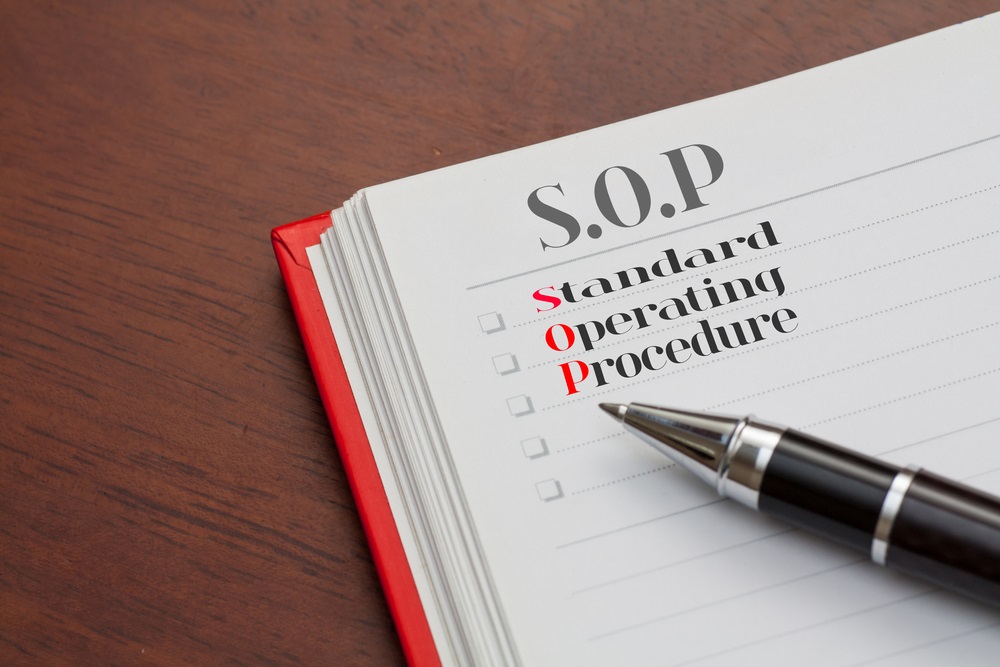If you want to see your company flourish, discipline and consistency are what you need to bring in If you want to see your company succeed, discipline and consistency are what you need to bring to each workflow. When the companies grow over time, managing operations become more complex, which can make you compromise on the quality of the services. That is when SOPs come in! The benefits of Standard Operating procedures (SOPs) are endless. The importance of standard operating procedures cannot be denied!
We agree with what MaintainX has to say about SOPs, “Whether attempting to sell the world’s tangiest loaves of sourdough bread or recycle 5K tons of non-ferrous metals every day, standard operating procedures (SOP) help busy teams consistently meet consumer demand and company standards with minimal errors.”
How To Make Standard Operating Procedures (SOPs) – Top 7 Tips
Where SOP improves collaboration and efficiency, it also needs a lot of time and your attention to investigate every crucial business process and pen the protocols down. Well, it doesn’t mean you can present a poorly written SOP. Considered the pivotal point in business growth, SOPs accuracy is demanded. But, how can you develop the standard operating procedures that will not only engage the employee but clearly explain their responsibilities? What are the pain points of effective SOPs?!
1. Understand What You Want This SOP To Accomplish
Why exactly are you creating Standard Operating Procedures? Without determining your goals for developing SOP, you cannot even start writing an outline. You must have the vision, the aim, and a clear-cut answer to WHY and it should be knowledge-based. Be aware of how SOP executions will bring out the positive side of your company. Don’t make your SOP documents text-heavy and boring.
To better define the reason, highlight hurdles and complications found in existing processes. Having a solid basis for SOP helps in outlining the necessary activities for a better understanding of the reader. The best approach is to keep the end in mind and start writing each aspect crucial for fulfilling SOP’s objective.
Be sure to ask yourself:
- How will SOP help your company work more efficiently?
- Will it promote teamwork and better alliance?
- Is SOP written to make the company more compliant with industry standards?
- Are you creating an SOP for employees to follow guidelines for improved productivity?
- Is it designed to serve clientele most professionally?
- Does your SOP assist in developing absolute best practices?
- Are you writing your SOP as a guide or for highlighting essential steps of procedures?
What will be the purpose of standard operating procedures if the end-user fails to understand its real meaning and cannot follow guidelines? For achieving positive results, you must mention the main objective of SOPs at the top of the document. It will not only explain to your teams why following the SOP matters but also double the engagement levels.
2. List of Processes
Once you have explained WHY now move on to WHICH. By which, we mean which processes must be mentioned in SOPs or for what processes you will be creating a step-by-step guide. It is necessary to develop a list of processes for creating Company operations procedures and standards as it will assist in either combining multiple guidelines or splitting one into different SOPs. The managers better have a detailed discussion session with their teams and then forward the list to the management team for the final review and identifying redundancies.
While enlisting the processes, make sure to include only the ones that need standardization and the procedures foreseeing a change.
3. Write End-User Focused SOPs
Most importantly, the SOPs must be written from the audience’s perspective. You should understand your staff and gather knowledge about their professional experience, language skills, traits, etc., for a clearer picture of how you can relate your SOP to the reader. EVERYTHING must be suitable for the end-user! It must be impactful for your audience. A few tips include:
- Use easy-to-understand, consistent language.
- Don’t make it overwhelmingly detailed.
- Always add a glossary section.
- Use active voice.
- Be consistent in formatting.
- Stay laser-focused on the tangible responsibilities of the end-user.
- Never miss out on adding eye-catchy visuals, such as flowcharts, screenshots, diagrams, and videos.
- Do not use unacquainted abbreviations or terminologies.
- Use “must” for mandatory instructions.
Always put yourself in the employees’ shoes and decide which processes need to be mentioned to achieve overarching business goals rather than over-explaining.

4. Use SOPs For Minimizing Waste
Taiichi Ohno idealizes SOPs as a source of reducing particular types of operational waste for well-organized and competent resource usage. For example:
- Under-utilization of Skills is one of the biggest wastes that can be minimized with SOPs by addressing inefficient hiring processes, lack of communication, and wasteful administrative duties.
- Overproduction is considered an operational waste. With good SOPs, you can acknowledge erroneous market forecasts, bizarre customer needs, and unproductive use of automation.
- Highlighting recurrent reasons behind troubleshooting along with responsible consulting staff can fill the gaps and eliminate the risks of defects in organizational procedures. Another waste was removed!
- One of the most common wastes is waiting time. Through SOPs, you can identify possible delays, noticeable lop-sided workloads, and unacceptable employee absent-mindedness.
While writing the Standard Operating Procedure document, every skilled manager must be conscious and proactively look for ways to get rid of the common types of waste with world-class solutions.
5. Implementation of Electronic Data Management System
For easy management and automation of SOPs, it is advised to use user-friendly standard operating procedure software. Electronic Data Management System or Computerized Maintenance Management System software not only systematizes SOP development but offers wide-ranging convenient, smart features to:
- Develop SOPs without errors.
- Edit multiple SOPs from remote locations offline.
- Track changes.
- Download files easily.
- Save SOP templates for better customization.
- Create SOP or assign tasks even on smartphones.
- Monitor improvements.
- Ensure regulatory compliance.
Digitizing documents declutters your file mess, causing disorganization in your cabinets. It makes the standard operating procedure checklist scannable, measurable, and actionable.
6. Choose The Right SOP Format
Do you want to produce consistent results? Are you looking for ways to explain company processes unmistakably and briefly?
Pick the most straightforward format that adheres to the international standard ISO 9000 or something similar, lets you produce a precise list, and gives enough space to include necessary explanations. You can find a variety of formats to follow, but the most commonly used structures include:
Simple Step-By-Step List:
- Presented in a bulleted list.
- Written in short sentences.
- Best-suited to explain routinely workflows that need to be followed in a specific order.
- Suitable for developing safety guidelines.
Hierarchical Steps:
- Best-suited for complex procedures comprising a lot of steps.
- Based on primary & secondary checkboxes.
- Provides extra space to present additional information.
Flowchart:
- Best-suited for penning down detailed processes that can give not one but several possible outcomes.
- Helps explain the actions that must be taken in unpredictable scenarios.
- Makes SOP easy to read and comprehend visually.
- Provide better insights with standard operating procedure flow chart template.
With the proper standard operating procedure format, you will save yourself from creating unappealing, clumsy, and drudgery SOPs.
7. User-Friendly Template
Different tasks demand different Standard operating procedure templates to share the essence of a valuable message but ensure to follow consistency to make all of your SOPs appear the same way!
For organizing procedural documentation, pick the template that best conveys the information about task completion, as it will save time and energy. As Monitrium explained, “Pre-made SOP templates that are based on industry standards provide organizations with a solid foundation for SOP creation, speeding up the time to developing documentation.”
Most essential elements of the standard operating procedure manual template include:
- Title
- Scope
- Overview
- Necessary Tools
- Procedural Steps
- Attached Manuals
- Target department
- Accountability Measures
Always use industry-vetted templates to have an excellent starting point for SOPs and keep the battles of unnecessary formatting at bay. Use at least two templates to escape the last-moment problems in the final review.
Minimize Variability & Maximize Quality With Well-Written SOPs
Profits Plus Accountants are always ready to provide top-tier counseling services and offer complete guidance in writing company standard operating procedures for making task delegation convenient. Our experienced team assists in establishing best industrial practices and law-compliant policies while meeting your monitoring purposes.
With our SOPs, you will become stress-free about completing workflows on time. We ensure a unique client experience.

